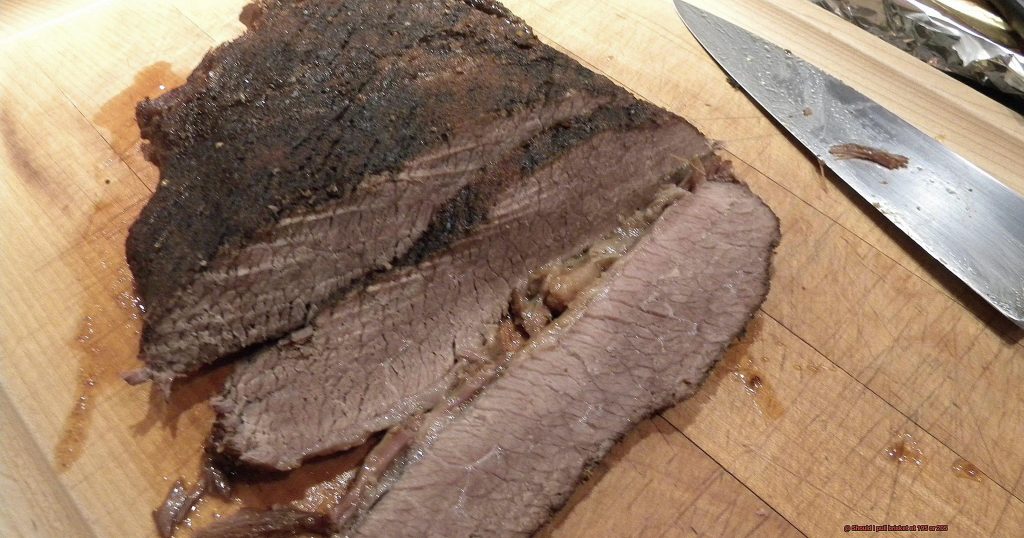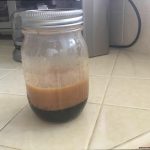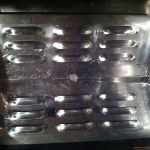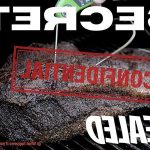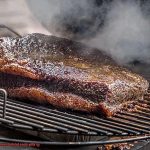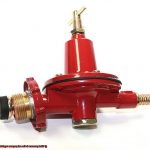Smoking a brisket is an art form that requires patience, skill, and attention to detail. From selecting the perfect cut of meat to achieving the ideal smoke ring, every step in the process matters. But when it comes to pulling the brisket at either 195 or 205 degrees Fahrenheit, opinions are divided among pitmasters.
The decision to pull at 195 or 205 may seem trivial, but it can make all the difference in the world when it comes to flavor and texture. Pulling at 195 will yield a tender but slightly dry brisket, while waiting until 205 will result in a juicier and more melt-in-your-mouth experience. It’s a delicate balance between cooking too long or not enough, and one misstep could mean disaster for your meat masterpiece.
So how do you decide which temperature is right for you? In this article, we’ll dive into the pros and cons of each option and share some expert tips on how to achieve that perfect level of tenderness and flavor. Whether you’re a seasoned pro or just starting out on your smoking journey, understanding the nuances of temperature control is crucial for creating a mouthwatering brisket that will have everyone asking for seconds (and thirds.). So grab your apron and let’s get started.
Contents
What Happens During the Cooking Process?
It’s not just about throwing meat on a grill or in an oven and hoping for the best. It requires patience, precision, and a deep understanding of the science behind rendering and collagen breakdown.
When you first place your brisket in the smoker or oven, it begins to absorb smoke and heat. This causes the fat and connective tissue within the meat to break down slowly over time. This process is known as rendering, and it is crucial to achieving a tender and juicy end product.
But that’s just the beginning. As the brisket cooks, its internal temperature gradually rises. At around 160-170°F, something magical happens. The collagen in the meat starts to liquefy and turn into gelatin. This is what gives the brisket its signature moist and tender texture.
Between 170-190°F, the brisket continues to cook and render until it reaches what’s known as the “stall.” During this plateau in the cooking process, the temperature of the meat seems to plateau or even drop slightly for several hours.
This can be frustrating for many home cooks, but it’s actually an essential step in achieving a perfectly cooked brisket. The meat is releasing moisture through evaporation, which can cool down the surface of the meat and slow down the cooking process. Trust us, it’s worth it.
After the stall, the brisket’s internal temperature will start to rise again until it reaches around 195-205°F. This is considered the ideal range for pulling a brisket off of the smoker or out of the oven.
Now here’s where things get interesting. There is some debate among pitmasters about whether 195°F or 205°F is the better temperature to pull a brisket. Some argue that pulling at 195°F produces a firmer texture and richer flavor profile, while others swear by the ultra-tender and melt-in-your-mouth texture achieved at 205°F.
Ultimately, the decision of whether to pull brisket at 195 or 205 degrees Fahrenheit comes down to personal preference and experience. The size and grade of your brisket, as well as your cooking equipment and technique, can also affect the ideal pulling temperature.
Pros and Cons of Pulling Brisket at 195 Degrees Fahrenheit
As a self-proclaimed brisket aficionado, I’m here to guide you through the pros and cons of pulling your brisket off the smoker at 195 degrees Fahrenheit. This decision is crucial in achieving that mouth-watering brisket, so let’s thoroughly explore the factors involved.
Firstly, pulling brisket at 195 degrees Fahrenheit can prevent overcooking, a common pitfall in meat smoking. Overcooked brisket becomes dry and tough, making it difficult to savor. By pulling it off at a lower temperature, you can ensure that it remains moist and tender, perfect for your taste buds to relish.
Another advantage of pulling brisket at 195 degrees Fahrenheit is the time saved. Cooking for a shorter period will require less attention to the smoker, especially helpful when cooking for a large group or preparing additional dishes.
However, there are some potential drawbacks to consider. If you prefer your brisket fully cooked through, pulling it at 195 degrees Fahrenheit may not be enough. Some pitmasters prefer their meat cooked all the way through while others like a slightly pink center. If you’re in the former category, waiting until 205 degrees Fahrenheit may be a better option.
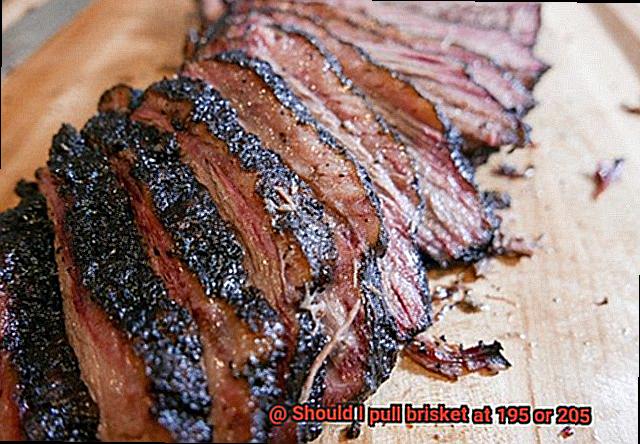
Furthermore, by pulling your brisket early, it may not have enough time to develop its flavor fully. Slow cooking is vital in breaking down connective tissue and developing that smoky flavor that makes brisket irresistible. If you pull it off too early, you risk missing out on these delicious flavors.
So what’s the final verdict? It ultimately comes down to personal preference and what you’re looking for in your finished product. Pulling it off at 195 degrees Fahrenheit guarantees moist and tender meat without overcooking. However, if you’re after a fully cooked and flavorful brisket, waiting until it reaches 205 degrees Fahrenheit could be the better choice.
Pros and Cons of Pulling Brisket at 205 Degrees Fahrenheit
Let’s delve into the pros and cons of pulling brisket at 205 degrees Fahrenheit.
First off, let’s talk about the pros. Pulling brisket at 205 degrees Fahrenheit leads to a more tender and juicy meat, thanks to the fully broken down connective tissue. The result is a melt-in-your-mouth texture that is sure to impress anyone who takes a bite. And let’s not forget about the rendered fat that adds to the overall flavor and moisture content of the brisket.
Another pro of pulling brisket at 205 degrees Fahrenheit is that it results in a more consistent cook. With enough time to break down fully, there is less chance of having any tough or chewy parts. This is especially important when cooking for larger groups, as you want every slice of brisket to be equally delicious.
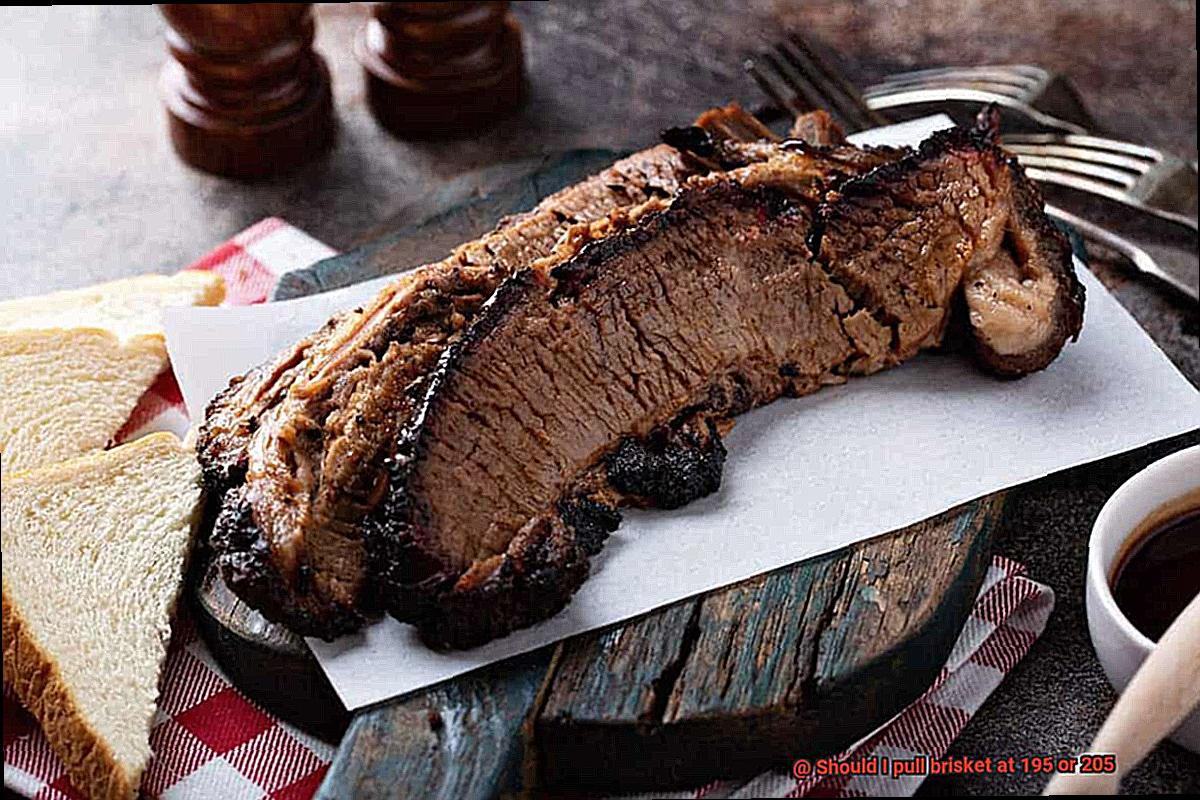
However, like anything else, there are also some cons to consider. One potential downside of pulling brisket at 205 degrees Fahrenheit is that overcooking can result in a slightly mushy texture. So make sure you keep an eye on your brisket and pull it off once it hits that magic number.
Additionally, since the fat has rendered down fully, there is a higher chance of the meat drying out if not properly wrapped or stored after cooking. And lastly, pulling brisket at 205 degrees Fahrenheit may take longer to cook than pulling it at 195 degrees Fahrenheit, so plan accordingly if you’re on a tight schedule.
Factors That Affect the Ideal Pulling Temperature
One of the most critical decisions to make when cooking brisket is determining the ideal pulling temperature. But don’t stress – we’ve got you covered with some essential factors to consider.
Size Matters
The size of your brisket is a crucial factor in determining the ideal pulling temperature. Larger briskets will require a higher temperature to break down the collagen and render fat properly. Smaller briskets, on the other hand, will cook faster, so a lower temperature may be required.
Type of Brisket
Different types of brisket may require different temperatures for optimal results. For example, wagyu briskets are known for their high levels of marbling, which means they may require lower temperatures to prevent overcooking and drying out.
Cooking Method
The cooking method used can significantly impact the ideal pulling temperature for your brisket. Smoking brisket at a low and slow temperature for an extended period may require a higher pulling temperature than cooking it in an oven at a higher temperature for a shorter time.
Texture Preferences
The desired texture of your brisket is also an essential factor to consider when deciding on the ideal pulling temperature. If you prefer your brisket to be more tender and fall apart easily, a higher pulling temperature may be necessary. However, if you prefer your brisket to be firmer and have a bit more chew, a lower temperature may be more suitable.
Resting Period
Don’t forget about the resting period after removing your brisket from heat. During this time, the internal temperature of your brisket will continue to rise by a few degrees. This means you may need to pull it slightly earlier than your desired final temperature.
Experimentation is Key to Finding the Sweet Spot
Look no further. The truth is there isn’t one “right” temperature that fits all. The ideal pulling temperature is dependent on several factors such as size, thickness, cooking method, and personal preference.
Some pitmasters advocate for 195°F, while others swear by 205°F as the sweet spot. However, the only way to truly discover your perfect sweet spot is through experimentation. Try cooking a few briskets at different temperatures and see which yields the result you’re after.
It’s essential to keep in mind that the internal temperature of the meat will continue to rise even after it’s removed from the smoker. So, it’s crucial to take this into account when deciding when to pull it.
Then, a lower temperature may be ideal for you. Or do you prefer a more flavorful and caramelized bark? In that case, a higher temperature may be your sweet spot. Ultimately, it all comes down to personal preference.
qsCVMmmNRec” >
Conclusion
As any pitmaster will tell you, smoking a brisket is an art form that requires patience, skill, and attention to detail. And when it comes to determining the ideal pulling temperature, there’s no shortage of debate among the experts. Should you go with 195°F or 205°F? Both options have their pros and cons.
If you’re looking for moist and tender meat without overcooking, pulling your brisket at 195°F is the way to go. This option results in a firmer texture and richer flavor profile that some folks just can’t get enough of. On the other hand, those who prefer a melt-in-your-mouth texture with fully broken down connective tissue should opt for pulling at 205°F.
Of course, there are plenty of factors that can affect your ideal pulling temperature – from the size and type of brisket to your chosen cooking method, texture preferences, and resting period. That’s why experimentation is key. There’s no one “right” temperature that works for everyone.
Mastering temperature control is absolutely essential if you want to create a truly mouthwatering brisket that will have your guests coming back for seconds.

